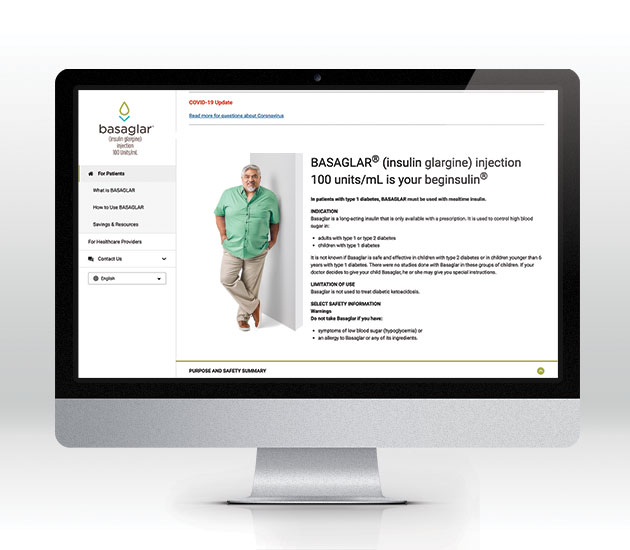IMPORTANT SAFETY INFORMATION
Contraindications -
BASAGLAR is contraindicated during episodes of hypoglycemia, and in patients with hypersensitivity to insulin glargine or any of the excipients in BASAGLAR.
Warnings and Precautions
BASAGLAR prefilled pens must never be shared between patients, even if the needle is changed. Sharing poses a risk of transmission of blood borne pathogens.
Changes in insulin strength, manufacturer, type, injection site, or method of administration may affect glycemic control and predispose to hypoglycemia or hyperglycemia. Any changes in insulin regimen should be made cautiously and only under close medical supervision, and the frequency of blood glucose monitoring should be increased. Due to reports of hypoglycemia and hyperglycemia, advise patients who have repeatedly injected into areas of lipodystrophy or localized cutaneous amyloidosis to change the injection site to unaffected areas and closely monitor blood glucose. For patients with type 2 diabetes, dosage adjustments of concomitant anti-diabetic products may be needed.
Hypoglycemia is the most common adverse reaction associated with insulins, including BASAGLAR. Severe hypoglycemia can cause seizures, may be life-threatening, or cause death.
Accidental mix-ups between insulin products have been reported. To avoid hypoglycemia due to medication errors between BASAGLAR and other insulins, instruct patients to always check the insulin label before each injection.
Severe, life-threatening, generalized allergy, including anaphylaxis, can occur with insulins, including BASAGLAR. If hypersensitivity reactions occur, discontinue BASAGLAR; treat per standard of care and monitor until symptoms and signs resolve. BASAGLAR is contraindicated in patients who have had hypersensitivity reactions to insulin glargine or one of the excipients.
All insulins, including BASAGLAR, cause a shift in potassium from the extracellular to intracellular space, possibly leading to hypokalemia. Untreated hypokalemia may cause respiratory paralysis, ventricular arrhythmia, and death. Monitor potassium levels in patients at risk for hypokalemia if indicated.
Thiazolidinediones (TZDs), which are peroxisome proliferator-activated receptor (PPAR)-gamma agonists, can cause dose-related fluid retention, particularly when used in combination with insulin. Fluid retention may lead to or exacerbate heart failure. These patients should be observed for signs and symptoms of heart failure. If heart failure occurs, dosage reduction or discontinuation of TZD must be considered.
Adverse Reactions
Adverse reactions commonly (>5%) associated with insulin glargine products are: hypoglycemia, allergic reactions, injection site reaction, lipodystrophy, pruritus, rash, edema, and weight gain.
Drug Interactions
Certain drugs may affect glucose metabolism, requiring insulin dose adjustment and close monitoring of blood glucose.
The risk of hypoglycemia may increase when antidiabetic agents, ACE inhibitors, angiotensin II receptor blocking agents, disopyramide, fibrates, fluoxetine, monoamine oxidase inhibitors, pentoxifylline, pramlintide, salicylates, somatostatin analog (e.g., octreotide), and sulfonamide antibiotics are co-administered with BASAGLAR.
The blood glucose lowering effect of BASAGLAR may decrease when co-administered with atypical antipsychotics, corticosteroids, danazol, diuretics, estrogens, glucagon, isoniazid, niacin, oral contraceptives, phenothiazines, progestogens (e.g., in oral contraceptives), protease inhibitors, somatropin, sympathomimetic agents (e.g., albuterol, epinephrine, terbutaline), and thyroid hormones. The blood glucose lowering effect of BASAGLAR may increase or decrease when co-administered with alcohol, beta-blockers, clonidine, lithium salts, and pentamidine.
The signs and symptoms of hypoglycemia may be blunted when beta-blockers, clonidine, guanethidine, and reserpine are co-administered with BASAGLAR.
BV HCP ISI 14SEP2022
For more information, please see accompanying Full Prescribing Information and Patient Information. Please see Instructions for Use.



